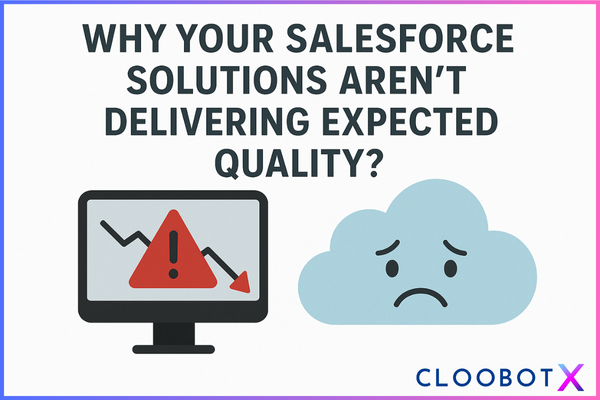Why Your Salesforce Solutions Aren’t Delivering Expected Quality
We all know that Salesforce is powerful but that power can easily spiral into complexity, and complexity has a quality cost.
You did not sign up for buggy workflows, inconsistent user experiences, or support tickets that feel like déjà vu. Yet here you are, reviewing UAT feedback that reads like a novel.
So what’s going wrong?
1. The Requirements Were Never Really Understood
We have all been in those “requirements gathering” meetings where half the team nods vaguely and the rest pretend to take notes. The truth is, when business needs get translated through three layers of email threads, Slack messages, and spreadsheet hell, something always gets lost in translation.
A missed edge case. An overlooked dependency. A critical assumption that no one said out loud.
This is not just a communication issue, it is a traceability issue. When specs are not rooted in context or version-controlled, your build starts on shaky ground.
2. Designs Are Reactive, Not Proactive
How often do architects get involved after the solution has already taken shape? By the time they surface, it is more about fixing what is already broken than building something robust.
High-quality solutions are never an accident. They arise from proactive architecture where metadata, dependencies, and patterns are analyzed before the first story hits Jira. When that is missing, even well-intentioned designs buckle under pressure.
3. The Documentation is Always “In Progress”
Let us talk about documentation, everyone’s favorite.
Except no one really updates it. It gets written once (maybe), filed somewhere forgettable, and never looked at again until someone new joins the team and asks, “Why was this built like that?”
In a high-velocity environment, outdated or incomplete documentation quietly erodes quality. Your devs are guessing. Your testers are improvising. Your users are paying the price.
Smart teams are moving toward living documentation, context-aware, automatically updated, and tightly tied to the implementation lifecycle. It is the only way to scale quality without slowing down.
4. QA is Still Playing Catch-up
The irony is that your QA team is held accountable for quality but they are often the last to get looped in. Requirements are not testable. Acceptance criteria are vague. Test scripts are rushed.
When QA is reactive, bugs become features, and technical debt multiplies.
The better way is to bake quality into the process itself. From the moment a user story is captured, it should carry clear, testable criteria. Execution-ready test scripts should not be an afterthought they should be an output.
5. No One is Managing the Hidden Debt
Behind every delayed deployment or underwhelming user experience, there is hidden debt including unused flows, redundant objects, hardcoded values, and forgotten automations. They don't just scream for attention, but they silently degrade performance and reliability.
What is needed is not more manual audits or "clean-up sprints" that never happen, but intelligent metadata analysis that flags issues before they snowball.
Final Thoughts
You’re not alone. Many Salesforce teams face these quality gaps not because they lack talent, but because the process lacks visibility, traceability, and automation.
If you want consistently high-quality solutions, you need more than just good people, you need systems that think with you. Systems that understand your org, evolve with your projects, and keep documentation and design aligned with reality.
Because quality isn’t just about testing harder. It’s about building smarter.
